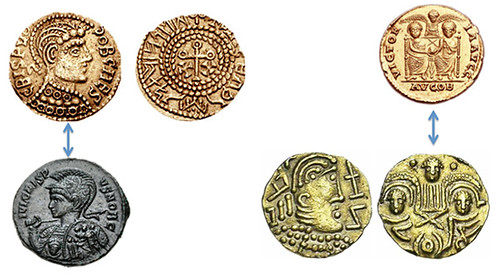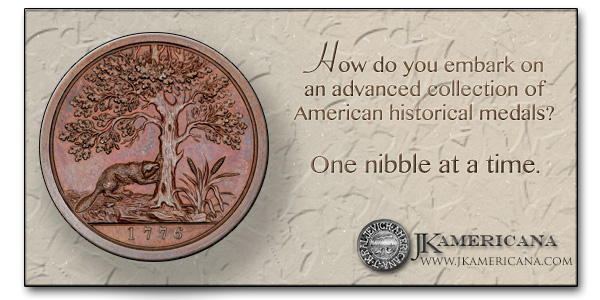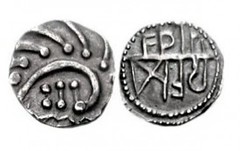
PREV ARTICLE
NEXT ARTICLE
FULL ISSUE
PREV FULL ISSUE
COINS OF THE ANGLO-SAXONSMike Markowitz had another nice article in CoinWeek this week. The topic is one we touched on in a couple of articles in last
week's E-Sylum - Anglo-Saxon coinage. Here's an excerpt. As always, be sure to read the complete article online. -Editor
A handful of larger coins, copied from late Roman solidi, were probably struck as royal gifts for special occasions. A hoard buried before 650 and discovered in 1828 at Crondall in Hampshire contained 73 diverse thrymsas, now in the Ashmolean Museum of Oxford University. Many have a crude bust on the obverse and a cross, surrounded by the name of a moneyer (such as WITMEN) on the reverse. “Moneyers” were private contractors, possibly goldsmiths, who produced coins on order for a king or bishop. Some thrymsas were struck at Canterbury, others at London. A few are known from York. Thrymsas became more and more debased over time, until they were just silver coins with a trace of gold. About the year 680 gold disappears from the coinage. The silver coins that continued to be struck were probably called “penningas”, but thanks to one of those historical misunderstandings so common in numismatics, they are known today by a different Anglo-Saxon word: sceat, or sceatta, which means “wealth” or “treasure.”  The so-called “primary sceattas” were struck for a period of about 25 years (c. 675-700). Thick coins, 12 – 13 mm in diameter, they weigh from 1.0 to 1.3 grams and are nearly pure silver (90-95%). Twenty grains of barley from the middle of the ear weigh almost exactly 1.3 grams, and this may have been the theoretical standard. The obverse design is typically a crude bust, with a few letters or runes of a fragmentary or garbled pseudo-inscription. A common reverse is derived from a “vexillum” – a Roman military standard or flag commonly depicted on fourth century coins. Another reverse type shows a bird atop a cross.
To read the complete article, see:  Wayne Homren, Editor The Numismatic Bibliomania Society is a non-profit organization promoting numismatic literature. See our web site at coinbooks.org. To submit items for publication in The E-Sylum, write to the Editor at this address: whomren@gmail.com To subscribe go to: https://my.binhost.com/lists/listinfo/esylum All Rights Reserved. NBS Home Page Contact the NBS webmaster 
|

